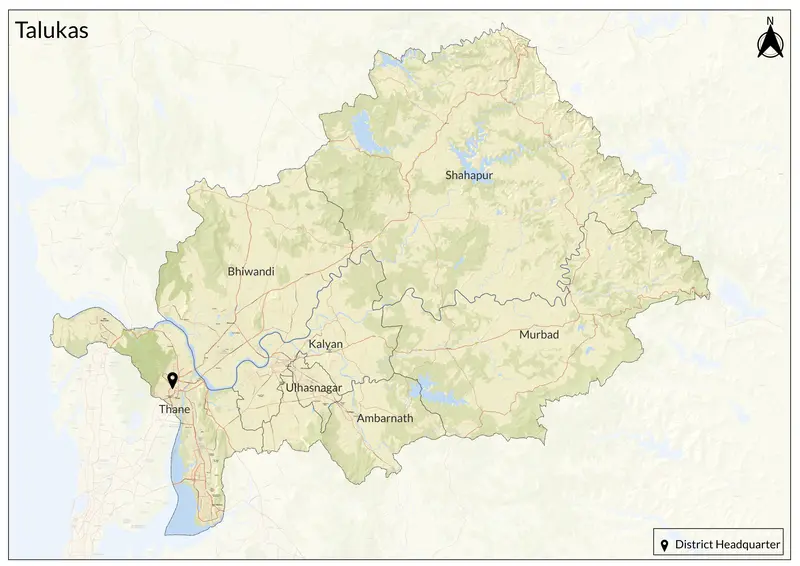Thane

9,558 sq. km
~1.25 crore (2019)
886 (2011) (includes Palghar)
~ ₹3.10 lakh crore (2019)
~ ₹2.50 lakh (2019)
Thane district, set along Maharashtra’s Konkan coast and bordering Mumbai, is one of the state’s most vibrant, urbanized, and historic regions. The district’s name originates from Sristhana (also rendered “Sthanaka” or “Thana” in old texts), a term meaning “place” or “station” and referenced in Shilahara, Yadava, and Sultanate records. Its administrative center is Thane city, now fully part of the Mumbai Metropolitan Region. Over centuries, Thane was ruled by the Mauryas, Shilaharas, Yadavas, Gujarat Sultanate, Portuguese (who constructed a key fort in the 16th century), Marathas, and finally the British, who made it the terminus of Asia’s first passenger train in 1853 and a district headquarters by the early 19th century.
In 1817, the area that is now Thane district was taken over by the British from the Peshwas and incorporated into the North Konkan district, with its headquarters located at Thana. Since then, the district's boundaries have changed several times, notably losing much of its territory with the creation of Palghar district in 2014. Thane was an important trade center under the Shilahara dynasty before coming under Portuguese and later British rule. In 1920, Salsette Island was divided into North and South Salsette talukas. South Salsette, consisting of 84 villages, was separated from Thane district and included in the newly created Bombay Suburban district. North Salsette was designated a mahal under Kalyan taluka in 1923 and later renamed Thane in 1926. Today, Thane district includes Thane, Kalyan, Murbad, Shahapur, Ulhasnagar, and Ambernath talukas.
The district features the Ulhas basin in the south and the hilly Vaitarna valley in the north, with plateaus and the Sahyadri slopes in the east. Land descends from Sahyadri’s steep slopes through plateaus to the Ulhas valley, separated from the coast by a narrow north–south hill ridge running parallel to the sea. Isolated hills and spurs also dot the district’s landscape. Creeks, such as Thane and Vasai, define the coast, and rivers like the Ulhas and Vaitarna, along with their reservoirs (Tansa, Modak Sagar, Bhatsa), are lifelines for Mumbai and the district’s population. Lush tropical forests remain in the eastern talukas, while wetlands and mangroves support rich biodiversity along the coast and creeks. Heavy monsoon rainfall shapes local agriculture and the seasonal life of the district, and the landscape is dotted with hot springs and scenic lakes, with Upvan, Masunda, and Talao Pali as famous urban oases. Thane is also known as the "District of Lakes", as it is home to several scenic lakes that play a crucial role in the local ecosystem and water system.
Thane is a melting pot of Marathi, Konkani, tribal, and a spectrum of North Indian influences, reflecting centuries of migration and proximity to Mumbai. The district has fostered traditional arts like Koli and Warli painting, salt farming, and vibrant stage drama, alongside cosmopolitan urban culture. The Ambreshwar Shiv Mandir in Ambarnath, built in the 11th century, is an architectural marvel. The Kopineshwar Mandir in Thane, also dedicated to Bhagwan Shiv, is one of the city's oldest mandirs. Another noteworthy landmark is St. John the Baptist Church. Ghodbunder Fort is another important historical site. Gadeshwar Dam and Barvi Dam are scenic spots popular among visitors and locals. Shahapur, known for its natural beauty, houses Mahuli Fort, a popular trekking destination. Major festivals blend local traditions with pan-Indian celebrations, and the area’s substantial Agri and Koli communities keep their distinctive customs alive in bustling markets and fishing villages
Once dominated by rice, horticulture, and fishing, it is now Maharashtra’s third most industrialized district—with MIDC estates, engineering works, chemical and pharma plants, textiles, and electronics clustered in Thane, Kalyan, Ulhasnagar, Ambernath, and Bhiwandi. Bhiwandi remains well-known for its powerloom industry and logistics hubs. Fisheries, floriculture, and fruit orchards like chikoo and mango thrive especially in peri-urban and tribal zones, while service and IT sectors are booming in satellite townships. The region’s role as a residential and commercial extension of Mumbai continues to drive its remarkable urban growth.
